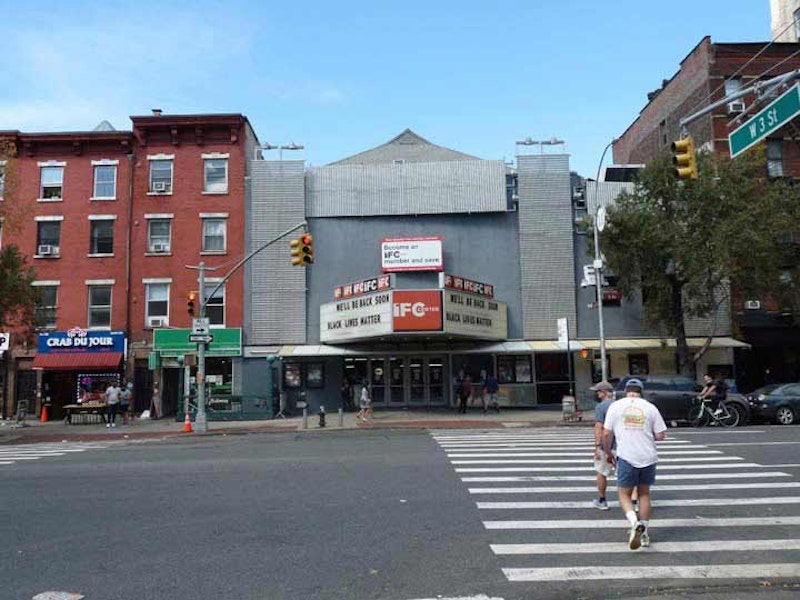Third St. runs from 6th Ave. east to Ave, D in the Village and East Village, with an interruption between Broadway and the Bowery in which its place is taken by Great Jones St. South of 8th St., Broadway is the divider of East and West numbered streets, but it only performs the duty for 3rd and 4th Sts., and only E. and W. 4th actually intersect Broadway.
Only its peaked roof is a giveaway that the IFC (Independent Film Channel) Center, at 323-325 6th Ave/ opposite W. 3rd, was once a church. It was constructed in 1853 as the West Reformed Dutch Church at a time when 6th Ave. was still called West Rd. The building remained home to solely a church until 1893, when part of it was leased to become a factory making glass used in stained glass church windows. In 1937 it was converted to the Waverly Theater and altered by architect Harrison Wiseman. Until 2001 the theater showed first-run pictures but was also an art house before running out of steam by 2001. That year it was purchased by the Independent Film cable TV channel and converted into a full-fledged art house, with a complete remodeling of the interior.

Two clubs at #130 W. 3rd, Fat Black Pussycat and Village Underground. This is a new Pussycat, named for the older one from the 1960s on Minetta St. off 6th Ave., whose painted sign persisted for decades after it had closed. The Village Underground is currently on the site of the old Gerde’s Folk City, which closed in 1986. No official plaque marks the spot of the Fillmore East, and none mark the locales of other legendary NYC rock venues such as CBGB, the Palladium, Bonds of Times Square, Folk City, Max’s Kansas City, the Peppermint Lounge (either of them), Danceteria, the Ritz, the Lone Star Cafe and many others. The building went up in 1875 as a repair shop for the FDNY.

At 85 W. 3rd St., Edgar Allan Poe lived and worked in 1845 and 1846. Some of his more famous works such as “The Facts in the Case of M. Valdemar” (which was made into a movie starring Vincent Price) were written here. Poe had three NYC residences: 85 Amity St. (renamed W. 3rd soon after Poe left the house), a farm in what is today W. 84th St., and the Poe Cottage in Fordham, Bronx. For 70 years this building hosted the popular Italian restaurant, Bertolotti’s. There was also a club called The Gold Bug.
In 2001 New York University tore down the house, which had never been landmarked, and built a large building to house the NYU Law School. However, the central building was designed to resemble the old building in which Poe had lived. The law school also hosts an annual Poe event.

This firehouse at #84 W. 3rd, built in 1906, looks like it had once been a FDNY firehouse, since it’s marked “Fire Patrol #2.” However, the FDNY and the Fire Patrol were two different entities. The Fire Patrol was established in 1839 by the New York Board of Fire Underwriters to protect and possibly save properties. The FDNY was established decades later and the Fire Patrol became sort of an auxiliary entity, while it continued to be underwritten by insurance agencies. The Patrol ceased operations in 2006. In 2010, TV personality Anderson Cooper purchased this firehouse.

LaGuardia Pl., which runs from W. Houston St. to Washington Square South, has gone by a variety of names. Starting out as Laurens St., it was once the north end of W. Broadway. Later it was known as South 5th Ave.; Robert Moses once wanted to connect it to 5th Ave. and put a road straight through the square.
Neil Estern‘s 1994 sculpture embodies the enthusiasm NYC’s 99th mayor, Fiorello LaGuardia, brought to City Hall for 12 years, 1933 to 1945. Estern’s 1965 bust of John F. Kennedy is at Grand Army Plaza, Brooklyn. A second likeness of LaGuardia can be seen at the Marine Air Terminal at LaGuardia Airport. Though he was born on the Lower East Side of Manhattan, LaGuardia grew up in Arizona. While still a teenager, LaGuardia worked at the US Consulates in Hungary and Trieste. LaGuardia spoke Yiddish, Italian, German, French and some Croatian dialects.

The somewhat forbidding-looking Elmer Holmes Bobst Library at W. 3rd and LaGuardia Pl. is clad in red sandstone with a minimum of windows. It opened in 1973, designed by architect Philip Johnson, with an $11 million grant from philanthropist Bobst, a friend of Richard Nixon’s. NYU liked the design, since other buildings in the complex are also clad in red sandstone. NYU accepted the grant despite Bobst’s recorded anti-Semitism.
Next week, I’ll plunge further east on 3rd St.
—Kevin Walsh is the webmaster of the award-winning website Forgotten NY, and the author of the books Forgotten New York (HarperCollins, 2006) and also, with the Greater Astoria Historical Society, Forgotten Queens (Arcadia, 2013)

